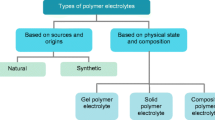Abstract
In this communication, we report the synthesis and characterization of a new donor–acceptor type conjugated polymer carrying alternate 3,4-didodecyloxythiophene and (1,3,4-oxadiazol-yl)pyridine moieties and evaluation of its optical and electrochemical properties. The polymer was synthesized through precursor polyhydrazide route. It has well defined structure, stability and it shows good solubility in common organic solvents. Optical and electrochemical properties were studied by UV-visible, fluorescence spectroscopy and cyclic voltammetric studies, respectively. It displays bluish-green fluorescence both in solution and in film state. Cyclic voltammetric studies showed that the polymer P1 possesses a HOMO energy level of −6·01 and LUMO energy level of −3·34 eV. The preliminary studies clearly reveal that the new polymer can have potential application in the fabrication of light emitting diodes. The studies on its device application are in progress.








Similar content being viewed by others
References
Argun A A, Cirpan A and Reynolds J R 2003 Adv. Mater. 15 1338
Brabec C J, Sariciftci N S and Hummelen J C 2001 Adv. Funct. Mater. 11 15
Bradley D D C 1993 Synth. Met. 54 4031
Burroughes J H et al 1990 Nature 347 539
Carvini R 2007 Appl. Phys. Lett. 79 2131
Carvini R, Spencer G W C, Holmes A B, Moratti S C and Friend R 1997 Synth. Met. 84 359
Davey A P, Elliott S, O’Conner O and Blau W J 1995 Chem. Soc. Chem. Commun. 14 1433 (doi:10.1039/C39950001433)
deLeeuw D M, Simenon M M J, Brown A B and Einerhand R E F 1997 Synth. Met. 87 53
Friend R H et al 1999 Nature 121 397
Grem G, Leditzky G, Ullrich B and Leising G 1992 Adv. Mater. 4 36
Im W-B, Hwang H-K, Lee L-G, Han K and Kim Y 2001 Appl. Phys. Lett. 79 1387
Janietz S, Wedel A and Friedrich R 1997 Synth. Met. 84 381
Leclerc M J 2001 Polym. Sci. Part A: Polym. Chem. 39 2867
Li Najun et al 2004 Mater. Lett. 25 3115
McQuade D T, Pullen A E and Swager T M 2000 Chem. Rev. 100 2537
Pei J, Yu W-L, Haung W and Heeger A J 2000 Chem. Commun. 1631
Skotheim T A and Reynolds J R 1998 Handbook of conducting polymers: processing and application, CRC publication (Taylor and Francis group) 3rd ed. (New York: Marcel Dekker Inc)
Strukelji M, Papadimitrakooulous F, Miller T M and Rothberg L J 1995 Science 267 1969
Stutzmann N, Friend R H and Sirringhaus H 2003 Science 299 188
Thompson B C et al 2005 New J. Chem. 29 1128
Udayakumar D and Adhikari A V 2006 Synth. Met. 156 1168
Yang Chen-Jen and Jenekhe Samson A 1995 Macromol. 28 1180
Acknowledgements
We are grateful to NMR Research Centre, Indian Institute of Science, Bangalore and Regional Research Laboratory, Trivandrum, for instrumental analyses.
Author information
Authors and Affiliations
Corresponding author
Rights and permissions
About this article
Cite this article
HEGDE, P.K., ADHIKARI, A.V. & MANJUNATHA, M.G. Electrochemical and optical properties of a new donor–acceptor type conjugated polymer derived from 3,4–didodecyloxythiophene. Bull Mater Sci 33, 677–682 (2010). https://doi.org/10.1007/s12034-011-0135-z
Received:
Revised:
Published:
Issue Date:
DOI: https://doi.org/10.1007/s12034-011-0135-z




